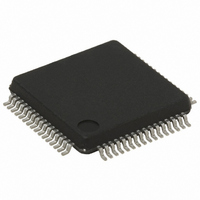ST72F321BR9T6 STMicroelectronics, ST72F321BR9T6 Datasheet - Page 184

ST72F321BR9T6
Manufacturer Part Number
ST72F321BR9T6
Description
MCU 8BIT 60KB FLASH/ROM 64-LQFP
Manufacturer
STMicroelectronics
Series
ST7r
Datasheet
1.ST72F321BK6T6.pdf
(187 pages)
Specifications of ST72F321BR9T6
Core Processor
ST7
Core Size
8-Bit
Speed
8MHz
Connectivity
I²C, SCI, SPI
Peripherals
LVD, POR, PWM, WDT
Number Of I /o
48
Program Memory Size
60KB (60K x 8)
Program Memory Type
FLASH
Ram Size
2K x 8
Voltage - Supply (vcc/vdd)
3.8 V ~ 5.5 V
Data Converters
A/D 16x10b
Oscillator Type
Internal
Operating Temperature
-40°C ~ 85°C
Package / Case
64-LQFP
Processor Series
ST72F3x
Core
ST7
Data Bus Width
8 bit
Data Ram Size
2 KB
Interface Type
I2C, SCI, SPI
Maximum Clock Frequency
8 MHz
Number Of Programmable I/os
48
Number Of Timers
2
Maximum Operating Temperature
+ 85 C
Mounting Style
SMD/SMT
Development Tools By Supplier
ST7232X-EVAL, ST7232X-SK/RAIS, ST72321B-D/RAIS, ST7MDT20-DVP3, STX-RLINK
Minimum Operating Temperature
- 40 C
On-chip Adc
10 bit, 16 Channel
Cpu Family
ST7
Device Core Size
8b
Frequency (max)
8MHz
Total Internal Ram Size
2KB
# I/os (max)
48
Number Of Timers - General Purpose
2
Operating Supply Voltage (typ)
5V
Operating Supply Voltage (max)
5.5V
Operating Supply Voltage (min)
3.8V
Instruction Set Architecture
CISC
Operating Temp Range
-40C to 85C
Operating Temperature Classification
Industrial
Mounting
Surface Mount
Pin Count
64
Package Type
LQFP
For Use With
497-5046 - KIT TOOL FOR ST7/UPSD/STR7 MCU
Lead Free Status / RoHS Status
Lead free / RoHS Compliant
Eeprom Size
-
Lead Free Status / Rohs Status
Details
Other names
497-5586
Available stocks
Company
Part Number
Manufacturer
Quantity
Price
Company:
Part Number:
ST72F321BR9T6
Manufacturer:
STMicroelectronics
Quantity:
10 000
ST72321BRx, ST72321BARx ST72321BJx, ST72321BKx
LD sema,A
IRET
Case 2: Writing to PxOR or PxDDR with Global In-
terrupts Disabled:
SIM
LD A,PFDR
AND A,#$02
LD X,A
PxOR/PxDDR
LD A,#$90
LD PFDDR,A; Write into PFDDR
LD A,#$ff
LD PFOR,A
LD A,PFDR
AND A,#$02
LD Y,A
PxDDR
LD A,X
cp A,#$02
jrne OUT
TNZ Y
jrne OUT
LD A,#$01
LD sema,A ; set the semaphore to '1' if edge is
detected
RIM
LD A,sema ; check the semaphore status
CP A,#$01
jrne OUT
call call_routine; call the interrupt routine
RIM
OUT:
JP while_loop
.call_routine ; entry to call_routine
PUSH A
PUSH X
PUSH CC
.ext1_rt
LD A,#$00
LD sema,A
IRET
184/187
; set the interrupt mask
; store the level before writing to
; store the level after writing to PxOR/
; check for falling edge
RIM
; entry to interrupt routine
; reset the interrupt mask
; Write to PFOR
15.1.3
interrupt routine
When an active interrupt request occurs at the
same time as the related flag is being cleared, an
unwanted reset may occur.
Note: clearing the related interrupt mask will not
generate an unwanted reset
Concurrent interrupt context
The symptom does not occur when the interrupts
are handled normally, i.e.
when:
– The interrupt flag is cleared within its own inter-
– The interrupt flag is cleared within any interrupt
– The interrupt flag is cleared in any part of the
If these conditions are not met, the symptom can
be avoided by implementing the following se-
quence:
Perform SIM and RIM operation before and after
resetting an active interrupt request.
Example:
Nested interrupt context:
The symptom does not occur when the interrupts
are handled normally, i.e.
when:
– The interrupt flag is cleared within its own inter-
– The interrupt flag is cleared within any interrupt
– The interrupt flag is cleared in any part of the
If these conditions are not met, the symptom can
be avoided by implementing the following se-
quence:
rupt routine
routine
code while this interrupt is disabled
rupt routine
routine with higher or identical priority level
code while this interrupt is disabled
SIM
reset interrupt flag
RIM
PUSH CC
SIM
reset interrupt flag
POP CC
Clearing
active
interrupts
outside











